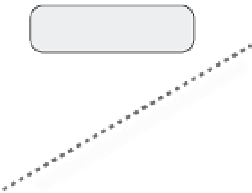Geology Reference
In-Depth Information
could reveal the average rate of erosion of the
entire upstream catchment! Under some geolog-
ical circumstances, assessing the cosmogenic
radionuclide concentrations in detrital mineral
grains can indeed indicate the mean erosion rate
across a catchment (Brown
et al.
, 1995; Granger
et al.
, 1996). The rate of accumulation of cosmo-
genic nuclides in rocks at the Earth's surface is a
function of at least two factors: the rate at which
the rock surface is being lowered by erosion,
and the altitude-dependent rate of nuclide pro-
duction (Fig. 7.16). Because this altitude depend-
ence is quite well known (a factor of e increase
for about each 1700 m of altitude gain), a simple
multiplication of the catchment hypsometry by
the altitude-dependent production rate can be
used to calculate a mean production rate for the
entire catchment. If there were no erosion, then
the nuclide abundance would increase to a
maximum, where the rate of production was
balanced by the rate of radioactive decay of the
nuclide (i.e., “secular equilibrium”). In the face
of erosion, a parcel of rock in the subsurface is
gradually brought toward the surface, is exposed
to increasing amounts of cosmic-ray bombard-
ment as it approaches the surface, and attains a
cosmogenic nuclide abundance that is a func-
tion of the rate at which the surface is being
eroded (Fig. 7.12). If quartz grains from through-
out the catchment contribute to the sediment
load in proportion to the local erosion rate,
then assessment of the concentration of cosmo-
genic radionuclides in a sample consisting of
many detrital quartz grains can reveal the basin-
wide mean erosion rate.
Unlike short-term measurements of sediment
fluxes during recent decades, the cosmogenic
nuclide signal integrates hundreds to thou-
sands of years of denudation and, therefore,
has the potential to yield erosion rates that are
largely free of anthropogenic perturbations. In
the past 15 years, many dozens of studies have
exploited detrital cosmogenic nuclide concen-
trations to define catchment-wide erosion rates
over hundreds to many thousands of years.
Such studies have led to a quantum leap in our
understanding of changing erosion rates at dif-
ferent time scales (Kirchner
et al.
, 2001), con-
trasts in rates across diverse tectonic landscapes
10
8
Cosmogenic
Concentrations
0.1
1
10
100
1000
erosion rates
(m/Myr)
10
7
10
6
10
5
10
4
10
3
10
2
2
3
4
5
6
7
10
8
10
10
10
10
10
10
A
Time (years)
10
3
10
2
10
1
10
0
10
-1
10
-2
4
5
6
7
10
8
10
10
10
10
B
10
Be (atoms/gram)
Fig. 7.16
Rock-surface erosion and cosmogenic
concentrations.
A. Theoretical
10
Be accumulation based on mid-latitude,
sea-level production rates at the upper surface of a rock
as a function of time and erosion rate. With higher rates
of erosion,
10
Be reaches steady state more rapidly and
at lower concentrations. The dashed line indicates the
approximate time for an originally pristine surface to
reach an equilibrium concentration whereby production
and decay are in balance for a given erosion rate. For
sustained erosion at 1000 m/Myr, a steady concentration
is reached in less than 3000 years, the time required to
remove about 2.4 m of rock (equal to four e-folding
depths of rock). B. Apparent erosion rates as a function
of steady-state
10
Be concentrations. At rates less than
1 m/Myr, radioactive decay accounts for most of the
nuclide loss and steady-state concentrations do not
indicate mean erosion rates. Modified after
Brown
et al.
(1995).
(Vance
et al.
, 2003; von Blanckenburg, 2006),
and the influence of climate on erosion rates
(Riebe
et al.
, 2001, 2003).
Although attractive in concept, many assump-
tions lie behind most applications of this
cosmogenic technique. These assumptions
include: uniform distribution of the target
mineral (quartz in most cosmogenic studies);
known production rates through time across
the catchment; uniform erosion throughout the





















































































































































































































































